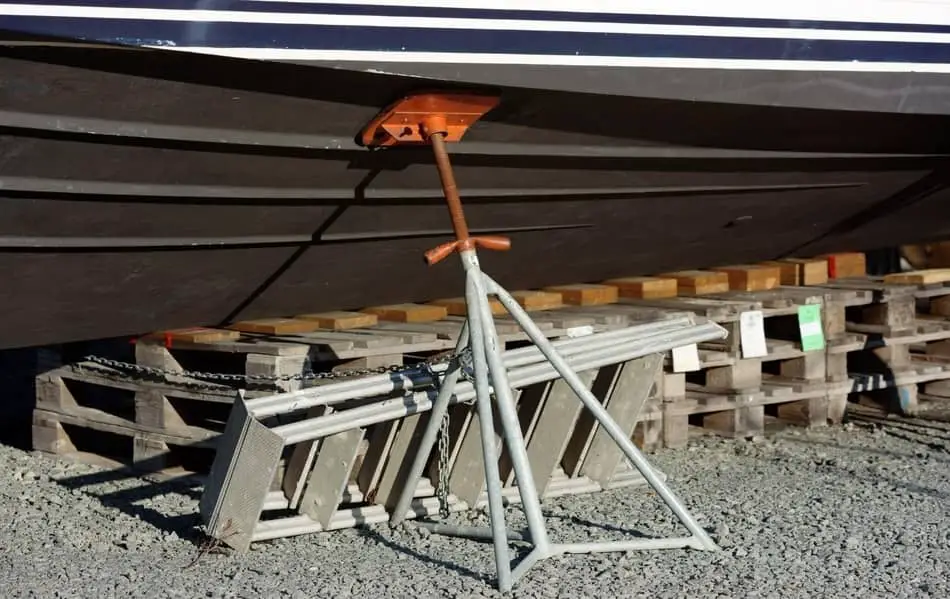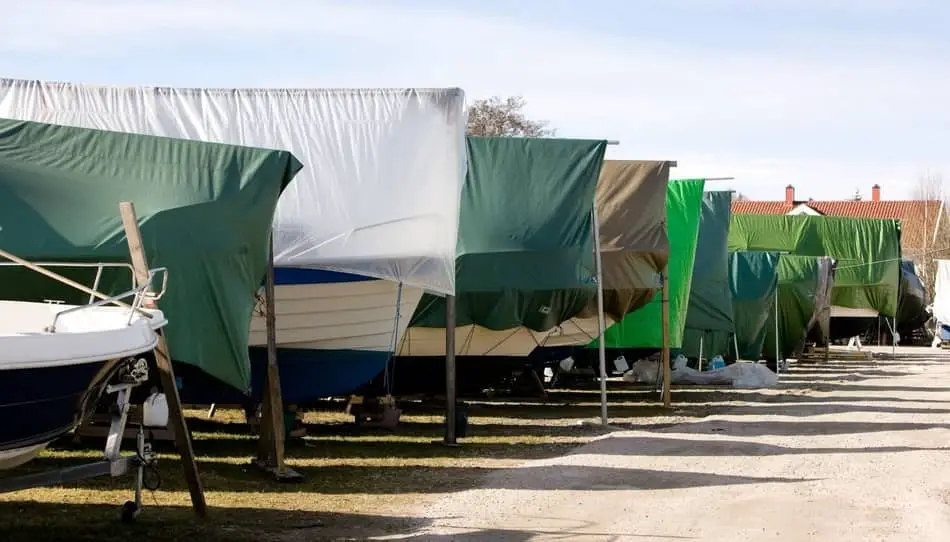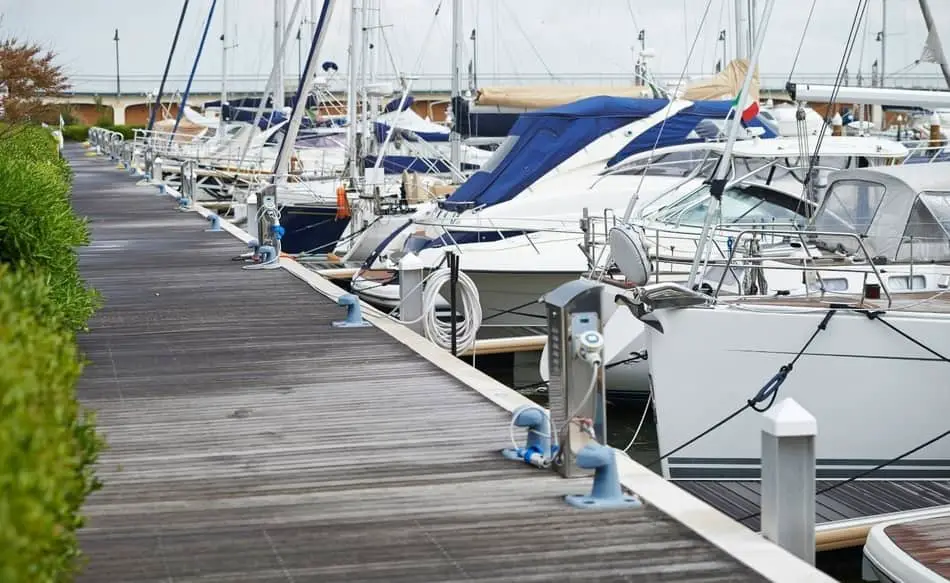Storing a boat is an essential task, whether it’s for winter storage or storing for a month. Here are some tips for storing your boat without a trailer.
- Store the boat using blocks and boat stands (blocking).
- Store the boat at the marina.
- Store the boat at dry-stacked storages.
Those three are the common ways to store a boat without a trailer. But, you need to know whether you want to store the boat at home or not. Besides storing the boat at the marina, for the rest of the storage options, you may need a trailer to take the boat to the storage place if they are not located near the marina.
Blocking the boat would be a perfect choice to store the boat without a trailer at home if you are more concerned about keeping the boat away from home at the marina or dry stacked storage or indoor/outdoor self-storage facilities.
Before storing the boat, you need to winterize the boat properly if you are storing it for winter. OR you need to stabilize the gas to prevent any problems in the future if you are storing the boat for 20 or 30 days.
Check my article on Winterizing a boat (link opens in a new tab) where I explained in detail how to winterize the boat in a step by step procedure.
Don’t leave the boat on the ground
Many people will leave the boat on the ground if they don’t have a boat trailer, don’t do that. Anything can damage the boat if you keep the boat on the ground. A boat on the ground can attract many small living creatures for winter nest.
Even if you cover the boat properly, don’t leave it on the ground. Keep something under the boat if you don’t have any blocks or stands. Don’t leave it simply on the ground without anything under the boat.
1. Store the boat using blocks and boat stands (blocking)

From the picture, you can see the whole set up. In such a way, you can store the boat without a trailer. And for a small boat most probably you don’t need long block under the keel; small ones are sufficient. But, if you want to store the boat at your home, then you might need to rent or borrow a boat trailer to bring the boat from the lake to the home.
Blocks – Used to lift the weight of the boat, and they are placed under the keel.
Boat Stands (aka jack stands or poppet stands) – Used to give support from the sides to prevent the boat from falling off.
You should use both the stand and the blocks to lift the boat. Don’t use only the stands to lift the boat because if you are using only the stands and not the blocks, then those stands can damage the boat hull. And the stands are not designed like that to hold the boat weight solely without the blocks.
By using a boat stands and blocks, you can store the boat at home if you have a storage place OR at a self-storage facility (indoor or outdoor) if you don’t have a storage place.
How many stands and blocks are required for a boat?
First, let us know how many stands and blocks are required for a boat with different lengths, and then we will go for tips (source).
Number of blocks required for a boat
Blocks – Minimum 2 blocks are required for a boat (one at the stern, one at the bow), and the number of blocks needed increases with 1 block for every increase of 10 feet length. See the below table to understand that correctly. (Block of any length above 20″ is okay, but width and height are essential).
| Boat length (in feet) | No. of blocks | Length, width, height (in inches) |
| less than 20 feet | 2 | 20″, 4″, 4″ |
| less than 30 feet | 3 | 20″, 6″, 6″ |
| less than 40 feet | 4 | 20″, 8″, 8″ |
Number of stands required for a boat
Boat stand – Minimum 4 stands are required for a boat (two at the stern, two at the bow), and the number of stands needed increases with 2 stands for every increase of 15 feet length. See the below table to understand that correctly.
| Boat length (in feet) | No. of stands |
| less than 15 feet | 4 |
| less than 30 feet | 6 |
| less than 45 feet | 8 |
These boat stands are essential for storing at home. Check the product in amazon click here OR the image is linked to Amazon.

These boat stands are essential for storing at home. Check the product in amazon click here OR the image is linked to Amazon. The boat stand in the below picture is for the keel.

Tips for blocking a boat
- First, choose the ground that is even without any slopes and don’t block the boat on the soft or loose ground (sand) because if you keep the blocks on soft grounds, then the blocks can penetrate a little bit into the soft ground, then the boat might be standing only with the help of the stands, which can damage the hull.
- Second, remove the unnecessary weight from the boat and ensure that the boat weight is distributed evenly on the blocks and stands to avoid any failures. It is good to remove extra weight from the boat so that stands and blocks won’t fail or break.
- Third, the blocks that are touching the boat keel under the boat should be wood, not concrete, or any hard materials because if the boat is kept on a concrete block, it can damage the boat hull easily.
- If the whole boat’s weight is lying on a hard surface, it can cause any dints on the boat keel. Wooden blocks are not like that; they are softer than concrete or any hard materials.
- First, keep the concrete block on the ground, then keep the wooden block on top of the concrete block, and then keep the boat on top of the wooden block (Concreate block –> Wooden block –> Boat).
- Still, you can use any rubber above the wooden blocks if you are concerned about any dints.
Blocking the boat would be a perfect choice to store the boat at home if you are more concerned about keeping the boat at the marina or dry stacked storage or indoor/outdoor storage facilities.
Benefits of storing the boat at home (by blocking)
- You can check the boat’s condition regularly and easily instead of going to the marina or storage places.
- Storing at home is free of cost.
- You can protect the boat from theft.
- You can go for boating whenever you want. There are no time restrictions, such as in the case of storing at dry-stacked storages or indoor or outdoor self-storage facilities.
Drawbacks of storing the boats at home (by blocking)
- Every time you need to rent or borrow a trailer, then only you can take the boat to the lake or sea. First, you need to go to the dealer for the trailer and then the boat; it’s double work.
- Taking the boat off a trailer might be a bit difficult. And taking the boat off the blocks might be difficult.
- Using stands and blocks might be difficult at the beginning, and you need at least two members to keep the boat on the blocks safely.
- If you are storing the boat outside your home, then you need to take extra care or maintenance for the boat, such as covering the boat properly to prevent any damages from rain or snow or sunlight and theft as well.
If you have space to keep your boat at home, then you can block your boat at home. Otherwise, you can keep your boat at indoor or outdoor self-storage facilities.
These self-storage places are not the same as dry-stacked storage. In self-storage facilities, they keep the boat on the ground, whereas in dry-stacked storage, they keep the boat on top of another like items in a rack.

Benefits of storing the boat at indoor or outdoor self-storage facility (by blocking)
- Most of the self-storage facilities will have CCTV’s to protect your boat from thefts.
- If you are storing the boat at an indoor self-storage facility, it gives protection to your boat from sunlight, rains, snow, etc.
- Outdoor self-storage facilities are cheaper than storing at the marina or dry-stacked storage.
- You can find self-storage facilities anywhere because they are so may self-storage facilities in the country.
Drawbacks of storing the boat at indoor or outdoor self-storage facility (by blocking)
- If you are keeping the boat at outdoor self-storage, you may need to take extra care, such as covering the boat from the rain, snow, sunlight, etc.
- If the self-storage facilities aren’t located near the marina, you might need to rent or borrow a trailer to take your boat to the self-storage facility.
- Storing the boat at indoor or outdoor self-storage facilities is expensive in some places.
2. Store the boat at the marina

Another choice to store a boat without a trailer is at the marina. You can store the boat at a marina by paying a monthly fee. So, you don’t need a trailer for storing the boat.
You can rent a covered marina slip instead of an open marina. If you decided to rent a marina slip, I would recommend you cover the boat with a boat cover.
Tips for storing the boat at the marina
- Bottom paint is essential for a boat to store in the water at a marina. Barnacles or corrosion will form if you didn’t use bottom paint for the boat. Check my article on the Needs of bottom paint to know the uses of the bottom paint and for which boats it is necessary.
- Tie the boat properly at the marina so that the rope will not come off due to bad weather or any disturbances.
- Check the boat condition regularly at the marina (maybe every 10 days like that).
- Even if you leave the boat for three or four days at a marina, cover the boat with the boat cover so that nothing will enter inside the boat, such as any living creatures, water, and sunlight, etc.
- Make sure to remove the battery from the boat if you are storing it for long-term storage at a marina.
- Make sure that your bilge pump is working properly because they often fail. The boat can sink in the water if the bilge pump fails.
Benefits of storing the boat at the marina
- You can take the boat right away from the water quickly.
- You don’t have to worry about a boat trailer and the expenses.
Drawbacks of storing the boat at the marina
- Storing the boat at a marina might be expensive in some places.
- You need additional maintenance such as bottom paint to prevent barnacles or algae or corrosion on the boat hull.
- Bad weather and sunlight can damage the boat if it is not placed in a covered slip at the marina.
- You can’t ensure the security of your boat.
- There is a high chance for boat damage due to bad weather or while docking.
3. Store the boat at dry-stacked storage

In the above picture, you can see how the boats are stored in dry-stacked storages. They use forklifts to keep the boat on the top. Some of the dry-stacked storages are open (like in the picture), and some of them are closed (like a warehouse). So, you need need to consider that as well.
In all the places, you may not find the closed dry-stacked storages. If you are keeping the boat in open, dry-stacked storage, you might need to take extra care, such as covering the boat with a boat cover is sufficient to keep the boat out of sunlight and rain.
Benefits of storing the boat at dry-stacked storage
- Dry-stacked storages are safer than marinas because, at the marina, you store the boat in water, and barnacles or corrosions may form on the boat hull, or bad weather can cause any damage to the boat.
- People working at the dry-stacked storage will keep the boat in the water if you call them in advance and they will remove the boat out of the water. Meaning they will take care of the boat entirely from keeping the boat in the water and taking the boat out of the water.
- In dry-stacked storages, they will secure the boat properly using CCTV or some surveillance to avoid theft.
Drawbacks of storing the boat at dry-stacked storage
- Generally, all dry-stacked storages will have timings. Meaning you may not be able to take the boat out of the dry-stacked storage whenever you want.
- Storing the boat at dry-stacked storage is expensive in some places.
- Some dry-stacked storages may limit the number of times you can take your boat out of the storage. If you exceed that limit, you may need to pay extra to take the boat out of the storage.
- If the dry-stacked storages aren’t located near the marina, then you might need to rent or borrow a trailer to take your boat to the storage.
- Mostly, all the dry-stacked storages are for small boats. So, if you have a huge boat, then it might be a problem for you.
Check my article on Storing a boat trailer for winter (don’t worry, it will open in new tab) and winterize the boat properly.
Bottom line
If you don’t have a trailer, then you can store the boat at any of the places discussed above. But, if you store the boat at the storage, then you home you need to pay. And depending on the place where you live, the cost for the boat storage will vary greatly.
Don’t store the boat in the water at a marina, store it any dry places instead of wet places. Storing the boat in the water at the marina can damage your boat due to bad weather or any disturbances outside.
The better option would be to store the boat at home. So, you can reduce the cost. If you store your boat at home and don’t have a boat trailer, then you might need to borrow or rent a trailer to take the boat for boating and bring back the boat home.
